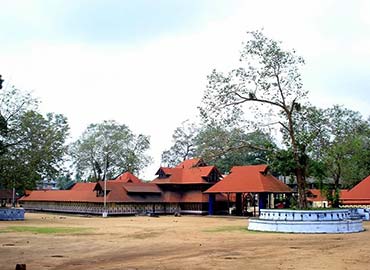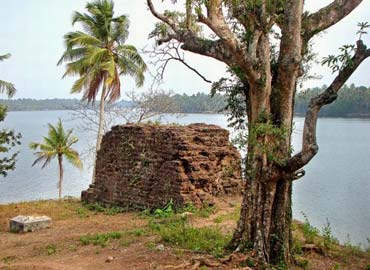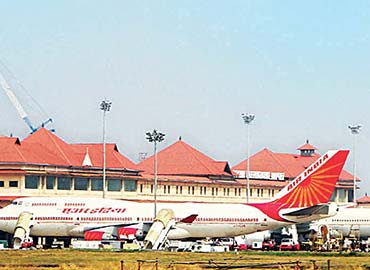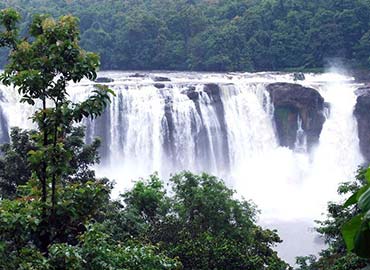
COLLege of law
AMBOOKAN ITTOOP MEMORIAL
0480 2890430 | +91 7306207243 | +91 9447969000
aimcollegeoflaw@gmail.com
100% PLACEMENT

AMBOOKAN ITTOOP MEMORIAL
0480 2890430 | +91 7306207243 | +91 9447969000
aimcollegeoflaw@gmail.com


Kodungallur Sree Kurumba Bhagavati Temple, Location Kodungallur Deity Bhadrakali (Maha Kali, Durga, Maha Lakshmi, Kannaki) District Thrissur District State Kerala Country India
Sree Kurumba Bhagavati Temple (alternatively Kodungallur Devi Temple) is a Hindu temple at Kodungallur, Thrissur District, Kerala state, India. It is dedicated to the goddess Bhadrakali, a form of Kali worshipped in Kerala. The goddess is known also by the names "Sri Kurumba" and "Kodungallur Amma" (The Mother of Kodungallur).This temple is the head of 64 sreekurumba kavs in Malabar. The murti of the temple represents the goddess in her fierce ('ugra') form, featuring eight hands with various attributes. One is holding the head of the demon king Daruka, another a sickle-shaped sword, next an anklet, another a bell, among others.

The Cheraman Juma Mosque is a mosque in Methala, Kodungallur Taluk, Thrissur District in the Indian state of Kerala.[1][2][3] Built in 629 AD, it is the first mosque in India.[4][5][6] It was built by Malik Deenar, an Arab propagator of Islam.[7][8][9][10] It is believed that this mosque was first renovated and reconstructed in the 11th century AD. Many non-Muslims conduct initiation ceremonies to the world of letters of their children here.[3]
Since ancient times, trade relations between Arabia and India were active. Even before the days of Muhammad, Arab traders visited the Malabari region, which was a major link between the ports of India and Southeast Asia. With the advent of Islam, the Arab merchants became carriers of the new[a] religion and they propagated it wherever they went.[14] One of the myths around the mosque is that Cheraman Perumal, the Chera king, went to Arabia, embraced Islam and changed his name to Tajuddin. He spent some time there, and died while returning in Dhufar, Oman.[15]
From there he had sent letters with Malik Ibn Dinar to his relatives in Kerala, asking them to be courteous to the latter.[16] See search of Burnell.[17]
In the 7th Century, a group of Arabs led by Malik Bin Deenar and Malik bin Habib arrived in Thrissur District constructed a Masjid at Kodungalloor, naming it after their contemporary Cheraman Perumal.[18]
The mosque has an ancient oil lamp which always burns and which is believed to be more than a thousand years old. People of all religions bring oil for the lamp as offering. Like most, this mosque allows entry for non-Muslims.[19] The then president of India Abdul Kalam is among the notable visitors to this mosque.
In April 2016, Indian Prime Minister Narendra Modi gifted a gold-plated replica of the Cheraman Juma Masjid to Saudi King Salman bin Abdulaziz Al Saud.

Kottappuram Fort, built by the Portuguese in 1523 was referred to popularly as Cranganore Fort and is now known as Kodungallur Fort. It was captured and destroyed by the Dutch in 1663. The Fort had a strategic position, on the mouth of the river Periyar before it joins the Arabian Sea, which gave it the advantage of controlling the ships and boats that passed to and from the interior of Malabar. A church and many traditional houses in the nearby area, built by the Europeans still remain today.
Kottappuram Fort played a significant role in many wars between the Zamorin and the rulers of Cochin (Kochi). In 1662 the Dutch fleet had made an attempt to capture it from the Portuguese, but that invasion was successful only in 1663. After taking over the Fort, the Dutch used it as an outhouse to guard their trade ships.

Muziris welcomes you to the cape of trade culture, left behind by its ancestors from around the world, to the waves of Azhikode where Christianity first entered India, to the Cheraman mosque, which gave out the first Muslim call for prayers, to the Bharani festival at the Kodungallur Bhagavathy temple, to the original culture of the Jewish synagogue, to the village where handlooms spin thinks of heritage, to the Palium palace and to the old waterways that led one to Muziris.
The Muziris heritage Project utilizes at a global level the possibilities of a region, which lost its glory centuries ago. Muziris is an ancient port town in little Kerala still holds a kind of beauty that is filled with history and culture. And through the project, we get ready to travel back in time for centuries. What this old port town dishes out to us along with history and culture, are the remnants of its past glory, still observable in features like place-names, architecture, diet etc. The Government of Kerala has initiated the Muziris Heritage Project to reinstate the historical and cultural significance of the legendary port of Muziris.

Cochin International Airport is an international airport serving the city of Kochi, in the state of Kerala, India. Located at Nedumbassery, about 25 km (16 mi) northeast of the city, Cochin International Airport is the first airport in India developed under a public-private partnership (PPP) model and was funded by nearly 10,000 non-resident Indians from 30 countries.[4] It is the busiest and largest airport in the state of Kerala. As of 2017, the Cochin International Airport caters to 63.86% of the total air passenger movement in Kerala.[5] It is also the fourth busiest airport in India in terms of international traffic[6] and seventh busiest overall. In fiscal year 2017-18, the airport handled around 10.2 million passengers with a total of 68,898 aircraft movements.[7] The airport is a primary base for Air India Expressoperations which is also headquartered in the city.

Athirappilly Fall, is situated in Athirappilly Panchayat, Chalakudy Taluk, Thrissur District of Kerala, India on the Chalakudy River, which originates from the upper reaches of the Western Ghats at the entrance to the Sholayar ranges.It is the largest waterfall in Kerala, which stands tall at 80 feet. Just a short drive from Athirapally to the Vazhachal falls, which is close to dense green forests that are home to many endangered and endemic species of flora and fauna. There is another waterfall on the way from Athirappilly to Vazhachal Falls, in close proximity to the road, which is locally called "Charpa Falls". Athirappilly Falls is the largest waterfall in Kerala and is nicknamed At a distance of 32 km from Chalakudy, 73 km from Kochi, 59 km from Thrissur, 100 km from Munnar, 122 km from Kottayam, 170 km from Kozhikode, 174 km from Coimbatore & 269 km from Trivandrum, Athirapally Waterfalls are one of the best waterfalls in India and one of the most famous tourist places in kerala & one of the popular weekend getaways from Kochi, Coimbatore & Munnar.